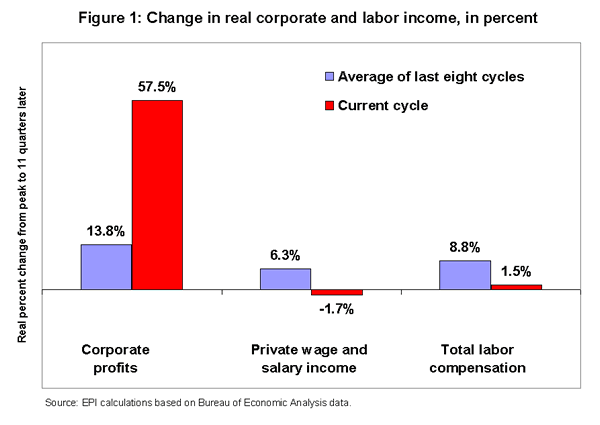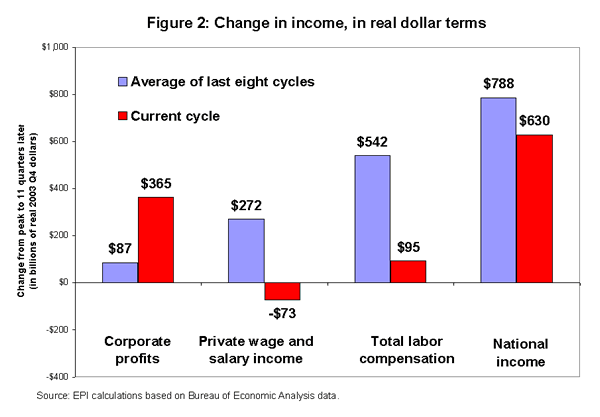See Snapshots Archive.
Snapshot for April 12, 2004.
Lopsided trends in profits and wages threaten to topple growth
The rise in the stock market over the last year reflects spectacular growth in profits but not a generally healthy economy nor sustainable growth. Profits have never fared better, nor wage and salary income so poorly for this period of the business cycle. Since the last expansion ended in the first quarter of 2001, corporate profits in the United States have expanded by 57.5%. Meanwhile, private wage and salary income has contracted by 1.7% and total labor compensation has increased by a meager 1.5%.
This imbalance is potentially bad news for the economy. Labor compensation is more likely to be converted to demand for domestic production and fuel a sustained growth spiral. In contrast, when income goes to corporate profits, a larger share is likely to be spent abroad (on imports or investments abroad) or to pay down debt.
Corporate profits grew from $635 billion in the first quarter of 2001 to exactly $1.0 trillion in the latest quarter of available data (the fourth quarter of 2003). In the eleven quarters after the peak of the previous eight business cycles (going back to 1948), profits rose by an average of 14% and never more than 21% (see Figure 1). Had profits grown at the average pace of the past, they would have been $278 billion lower.

While corporate profits expanded by $365 billion, private wage and salary income contracted by $73 billion (from $4,330 billion to $4,257), as shown in Figure 2. Had private wage and salary income grown at the 6.3% pace typical of the last eight cycles, it would have grown by $272 billion and be $344 billion higher than the actual level.

Other forms of labor compensation have grown, but at slower rates than in the past. Government wage and salary income grew 8%, down from the prior average of 12%. Likewise, all other labor costs (e.g., pension contributions, health insurance premiums, and payroll taxes) grew 10%, compared with 24% growth in earlier cycles.
Total labor compensation – wage and salary income plus other labor costs – has grown just 1.5%, far below the average 8.8% gain in past business cycles. If labor compensation had grown at the average pace of the past it would be $447 billion higher.
The nation’s income has grown more slowly in this cycle than in the past – 6.7% versus 8.4%, a difference of $158 billion. This recovery will not be on sound footing until a sustained growth in jobs and incomes kicks in.
Note: All numbers in this Snapshot are adjusted for inflation.
Today’s Snapshot was written by EPI Research Director Lee Price.
